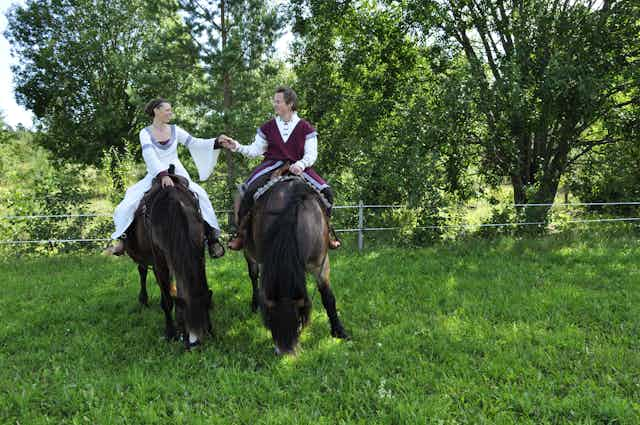A proposal to replace the legal requirement of the reading of banns before church weddings with a civil process has been put forward at the Church of England synod. The law requiring marriage banns to be read out aloud on three consecutive Sundays prior to marriage was introduced by the Catholic Church 800 years ago (almost to the day).
But how did this tradition come about? The reading of banns were an important step forward in the development of the institution of marriage and has been an indispensable part of marriage in Western Europe since then.
In ancient Roman times not everyone had equal marriage rights. If you were a slave you had neither the right to choose whether to marry nor to choose your partner. If you were allowed to marry your owner still had the power to station your spouse in another location even if it was in the other end of the Empire. He didn’t need to show any consideration towards your children and could employ them when and where he wanted: slaves were simply regarded as we would farm animals or machines today.

This unequal state of affairs changed with the introduction of Christianity. In the words of St Paul, Christians were neither “Jew nor Greek, bond nor free, male nor female”. Though it took time, the Christian church therefore sought to extend the right to marry to all believers.
By the eighth century it was a principle of the Christian church that everyone had the right to marry. This was a significant move forward from the situation in which the marriages of the unfree – peasants who held their land in return for cultivating it – was open to challenge in courts of law.
But theologians continued to debate the function that marriage served in man’s journey towards salvation. St Augustine, the fourth-century bishop of Hippo in North Africa, had established that for those who could not live a celibate life being married was essential to being Christian. In the words of a later (12th-century) theologian, marriage “removed the stain of sin from sexual intercourse and made that lifelong union happy and pleasant”. These considerations meant that soon marriage was not only made possible for all; it was encouraged.

Defining marriage
So, from around the 12th century, theologians, lawyers and popes set about making it as easy as possible to enter into marriage (and as difficult as possible to dissolve it). But while priests, preachers, and theologians dedicated their time to broadcasting the church’s ideology of marriage, it also became necessary to neatly define what marriage actually was. So it fell to the lawyers to provide a working definition that allowed everyone to enter into marriage with the minimum amount of fuss.
In the middle of the 12th century, Gratian, a teacher of law in Bologna, published what can best be described as the first academic textbook in the law of the Catholic Church. Although his solution was cumbersome, Gratian managed to reconcile the many contradictory texts which dealt with the thorny question of when marriage became legally binding.
He took his starting point in the nature of the words that spouses exchanged when they married. These words, he argued, initiated marriage, but marriage was only perfected by “a mingling of the sexes”. Gratian left the meaning of this phrase open to interpretation but made it clear that sexual intercourse was only one among several ways to perfect a marriage.
Achieving perfection
Though it was a good starting point for discussions by university law students, Gratian’s definition of marriage created serious problems in practice. Gratian did not define what constituted “perfection”. This meant it was extremely difficult to prove that a marriage had been perfected in a court of law.
Proof normally consisted in the evidence of two independent witnesses to the exchange of vows and to the “perfection” of the marriage, but even if the court could find witnesses to these two events, it remained unclear what would happen if one spouse died in between the initiation and the perfection of marriage. University scholars across Europe proposed several different solutions to the problem in the latter half of the 12th century, but it was not until the reign of Pope Alexander III (1159-1181) that an answer was promoted with papal authority.

Alexander III decided to follow the recommendations of scholars at the University of Paris and ruled that marriage was created simply when spouses both said they were married. No priest, no witnesses and no ceremonies were required. Alexander III’s decision marks the high water mark of easy access to marriage. This rule – that you contracted marriage by speaking the marriage vows – continued in England until Lord Hardwick’s marriage act in 1753.
To many clerics and lawyers this all felt a bit too easy, so it was felt that something was needed to safeguard marriages contracted by words alone. In attempt to do so the Fourth Lateran Council passed the rules in 1215 which required the reading of banns in church on three consecutive Sundays. In doing so, the council introduced a final principle: marriage was not just a matter between individuals but an institution that was protected by the community. The fact that you were legally able to marry – that you were marrying of your own free will, that you were not already married, that you were not too closely related, and that you were old enough to make the decision to marry – was guaranteed and testified to by every member of the local community.
The reading out of marriage banns may seem a bit archaic and so it’s perhaps understandable that there’s talk of them being scrapped. But what they stand for – the principle of community involvement in every marriage – is enshrined and continued still, in local registry offices publicly displaying notices of intentions to marry.

